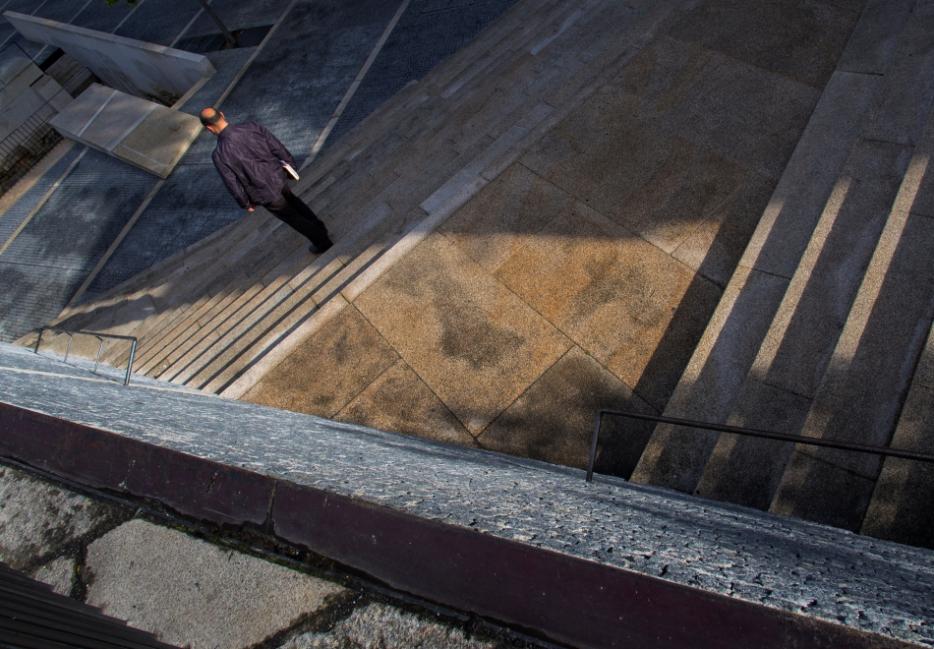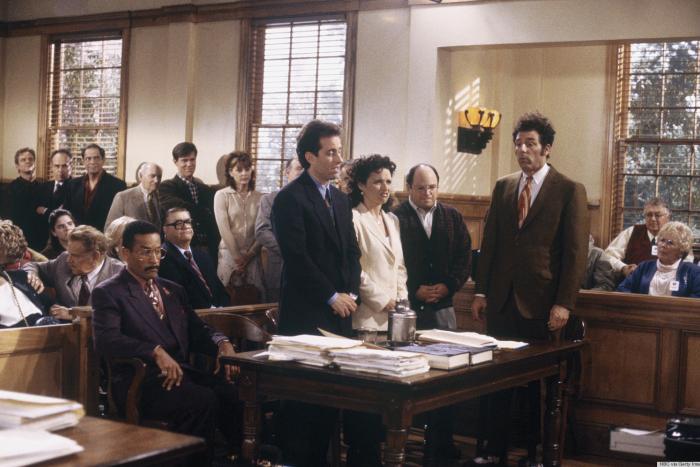A few weeks ago, I saw a video online. It was billed as the third webisode in a series called Can You Imagine? The hosts, Kevin and Steph, stand awkwardly on a set in dorky orange t-shirts with the letters RIT, for the Rochester Institute of Technology. Kevin is wearing his over top of a long-sleeve button-down shirt. The first 50 seconds are taken up with plugging the upcoming event Imagine RIT, the university’s innovation and creativity festival. “That’s right,” Steph says, nodding uncertainly and stumbling over the last word, “it’s where the left brain and right brain—collide.” After some frankly boring chit-chat, the hosts get down to the fun engineering feat they’ll be showing us today—a stairwell on the RIT campus with a neat architectural property.
Cut to a dingy stairwell. Kevin, ascending one flight of stairs, explains that the stairwell was designed by Filipino architect Rafael Nelson Avoganda. He reaches the top, turns the corner, and suddenly reappears at the bottom of the lower flight of stairs, leading up to the landing that he appears to have just left. The staircase, he says, climbing towards us, was built in 1968, and “has been wowing RIT students ever since.”
The video is about six minutes long, and there’s a man-on-the-street component (students on the RIT campus who have never heard of the staircase), followed by a number of staircase demos, in which unsuspecting students try the staircase and have their minds blown. Then a second man-on-the-street component, with students who know about the staircase. “Oh yeah, the staircase thing!” a girl says, turning to her friend. “Where you can’t ever—go—” she makes a spiralling motion with her hand.
My credulity in the architectural genius of Rafael Nelson Aboganda lasted about the length of forty-one capital A’s—when I shared the video on Facebook it was with the status “WHAAAAAAAAAAAAAAAAAAAAAAAAAAAAAAAAAAAAAAAAA is this fake?” Not to brag, but at least I didn’t drive five hours to Rochester to visit the amazing sight for myself. Which, last summer, a lot of people did, says Michael Lacanilao, the film’s creator.
“It really, really made me feel so bad,” Lacanilao said when I called him up to say, in essence, hey. “When I found out that some of them even drove up from Canada, like some people crossed borders to go there!” He had thought that people would see the video and be taken in for a maximum of 15 seconds before rational thought set in. Over the summer, he was taken aback by the flood of pilgrims showing up demanding to see the stairwell. “One couple was really, really angry. She told us that during her trip with her boyfriend they were arguing in the car about who would do the stairwell first. And they were both kind of scared like, ‘No, you do it first, No, I don’t know if I want to do it first.’”
The webisode is part of Lacanilao’s larger project; he’s currently running a Kickstarter campaign to raise the money to film a documentary about Aboganda, the stairwell’s fake architect, featuring real engineering experts giving false testimony about the science behind the stairwell’s design. He’s also creating a Googleable body of fake academic articles purporting to explain the stairwell’s mechanics (in my own defence, I thought the stairwell employed an optical illusion to give you the false sensation of ascending or descending, but Lacanilao says the idea is for viewers to believe it literally allows you to ascend down and descend up).
Part of Lacanilao’s interest is in how the internet has dulled our capacity for critical thinking. “The idea was to take something that was logically absurd—like a five-sided square—something that if you take 15 seconds to consider it, you can disprove it by pure reason.” A hint of frustration creeps into his voice, and I can imagine him trying to explain the staircase’s impossibility to flocks of couples on summer road-trips, holding hands and gazing at him with baffled disappointment. “It’s even more absurd than flying! A five-sided square isn’t even conceivable—it’s not logical.” Lacanilao pauses. “I don’t know if I’m being clear here.”
On balance, Lacanilao seems unsure whether he finds people’s credulity in the stairwell heartening or disheartening. While it may give him pause to see how many people are taken in by something so obviously untrue, as a filmmaker he also relies on audiences’ willingness to suspend their disbelief. He doesn’t conceive of the project as a hoax or a fake, but rather as an exercise in myth-building—he thinks of the staircase as Santa Claus for adults.
“I wanted to reignite those experiences I had as a kid—that sense of wonder and excitement,” he tells me. When I asked if he had believed in Santa as a kid, he said his parents used to adopt an attitude of bafflement about where the presents came from on Christmas morning. “I’d be like, Well, who left them here? And they’d be like, I don’t know nada! It was kind of an ‘I don’t know’ rather than a ‘this guy exists.’” He asked if I had believed in Santa and I told him that my parents didn’t like the idea of lying to children, so they never pretended there was any mystery about where the presents came from. “I think that’s great,” he said. “I feel the same way. I’d probably tell my kids there wasn’t one—it just feels weird lying about that, especially to kids.” Then he thought about it for a moment. “But then, I just made this impossible stairwell, so who am I to say?”






